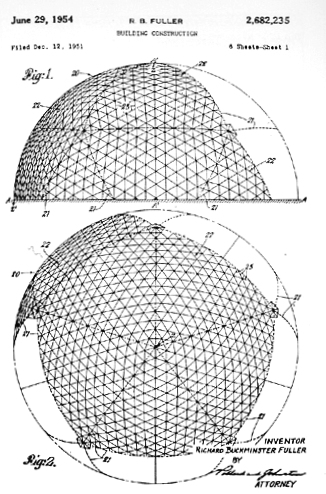Geodesic dome
Contents |
[edit] What is Geodesic
The word geodesic is Latin and means earth dividing and mathematically means the shortest path between two points on any mathematically defined surface. In theories or relativity, a geodesic describes the notion of the straight line to a curved space-time, the idea that falling or freely moving particles travel along a line or a geodesic.
[edit] Origins of the geodesic dome
The geodesic dome forms curved shapes from straight lines that frame surfaces. The name geodesic dome itself, is said to be attributed to Buckminster Fuller, who first used the term regularly and who revisited the form, as a construction technique, improving design and material efficiency sufficiently to patent and popularise its use. Today one might describe three forms of geometry as hyperbolic (concave lines), elliptic (convex lines) or Euclidian (parallel straight lines).
However as early as 600 BC theorists who's work was based on and around the teachings and beliefs of Pythagoras (570-495 BC) called the Pythagoreans, investigated the segments of volumetric shapes. This work developing segmented forms was further progressed by Plato (428-348 BC), further expending these forms, it was later recorded by Euclid (hence Euclidian) in around 300 BC in his thirteen books of Elements, in particular the final book XIII, describing regular solids from the pyramid, to the octahedron, the icosahedron and the dodecahedron.
[edit] The first geodesic dome
In 1919 first ideas of physically constructing a geometric structure came from the physicist Walther Wilhelm Johannes Bauersfeld (1879-1959) after being approached by Oskar von Miller from the Deutsche Museums with his idea of building a planetarium. Whilst the first ever planetarium had taken 7 years before being completed in 1781, by Eise Eisinga, this was a physical construct built in the living room of his house, von Miller's was to be the first world's first projected planetarium for a paying public.
Bauersfeld, was at the time, chief executive officer for the German manufacturer of optical systems and opto-electronics, Zeiss founded in Jena, Germany in the mid 1800's. He proposed using the Icosaedron (as had been described by Plato) as a concrete shell structure to house the projection, and the first dome was patented and built in 1924 as a test demonstration on the roof of the Zeiss factory in Jena by Dykerhoff and Wydmann.
The test had proved such a success, with over 80,000 visitors, that a larger permanent dome structure, called The Wonder of Jena was built in the city and opened to the public in July 1926. This dome was also a concrete shell structural dome but only six centimeters thick with a diameter of 25 metres. Further examples were then built in Munich and Berlin, these were not only the first examples of what was then called a Ptolemaic Planetarium and the projection system called the Model I, but also effectively the earliest examples of built geodesic dome structures.
[edit] The first Bucky geodesic dome
The geodesic dome however is often attributed to the American engineer and architect Richard Buckminster Fuller (Bucky) who further developed the method in the late 1940s. These Geodesic domes consisted of a network of framed triangles providing a self-balanced structural framework that used minimal materials, they were in some ways similar to the earlier concrete shell structures but more efficient in materiality.
Buckminster Fuller designed the geodesic dome following World War II as part of his experimentation to create affordable and efficient housing that could be built quickly from mass-produced parts, he built his own home as a prototype geodesic dome with his wife and lived there until 1971. These domes tended to be lightweight and in contrast to the previous domes theoretically easy to assemble and dis-assemble, similarly to the concrete domes they could also enclose large areas without requiring internal columns.
In 1953, Buckminster Fuller designed the first commercial dome for the Ford Motor Company headquarters in Michigan, after which he received a patent for the dome in 1954, it would enclose a central courtyard at the company’s imposing headquarters called the Rotunda. The gap over the courtyard was 93 feet (28 meters) across, so standard techniques would made the dome too heavy, crushing the supporting walls. Fullers design would weigh less than 10 tons, cost significantly less in materials and time, he finished the project ahead of schedule which gained him celebrity status. However a few years later, a team was sent to fix a suspected leak in the dome, and accidentally set the dome on fire totally destroying it.
Fuller viewed domes holistically and envisaged the possibilities of domes as ecosystem containers, even proposing a huge dome over part of Manhattan Island to moderate temperatures, equipped with air filters, it would improve health by lowering germ and virus counts. He also supplied a large number of domes to the US military which used them to cover radar stations (radomes) at installations around the Arctic Circle and lived all his life with his wife in the dome home he designed. In 1967 one of the most famous Bucky domes was the International and Universal Exposition in Montreal, a 76-meter dome, nearly 62 meters tall, serving as the architectural center piece to the fair it came to be known as the Montreal Biosphere.
[edit] The Climatron®
In 1960 another Bucky inspred was built, the Climatron® was one of the first geodesic domes to be used as a conservatory, and incorporating many of the principles of Buckminster Fuller, considered as the inventor of the geodesic system. The building was designed and developed by St. Louis architects Murphy and Mackey, and won the 1961 Reynolds Award in excellence for the its use of alumminum, and was named one of the 100 most significant architectural achievements in United States 15 years later. The term Climatron descrobed this early investigation into climate-control technology and the potential of bioshperes, with no interior support and no columns, it allowed more light and space per m2 for plants than conventional designs. It rose 20 metres at the center, with more than 50 metre spans and housing more than half an acre of internal space.
[edit] Efficiency
Geodesic domes are efficient structures in several ways:
- They are based on a network of triangles which are very stable shapes. If a force is applied to the corner of a triangle, it will retain its form, whereas other shapes, such as rectangles, will distort. This means that geodesic dome buildings are strong and resistant to forces such as those from snow loads, earthquakes and wind.
- The structural efficiency of geodesic domes means that they require less material than conventional buildings.
- For the volume that they enclose, geodesic domes have a much smaller surface area than traditional 'box-shaped' buildings. This means there is a reduced area exposed to external temperature changes and so they can be less expensive to heat and cool.
- The construction of geodesic domes can be very fast, and may not require the use of heavy equipment. This buildability is enhanced by the use of prefabricated components.
[edit] Uses of geodesic domes
It is believed that there are more than 300,000 geodesic domes around the world today. They can be constructed in a variety of sizes, with the largest being the 216m diameter Fukuoka Dome, a baseball stadium in Japan.
They are suitable for a wide range of uses:
- Sports stadiums.
- Theatres.
- Greenhouses.
- Exhibition halls.
- Children’s playgrounds.
- Emergency shelters.
- Military shelters.
- Radomes.
[edit] Components
The materials used for geodesic domes vary widely. For simple, movable structures, timber, PVC or galvanised steel frames covered with a thin architectural membrane (such as PVC polyester or ETFE foil) can be used. Larger, more permanent structures such as sports stadiums have been constructed with aluminium and steel frames covered with materials such as copper, aluminium, acrylic and Plexiglas panels.
[edit] Examples of geodesic domes
Geodesic domes can be seen around the world, including:
- The American exhibit at Expo 67 in Montreal.
- The largest geodesic dome at 216m in Fukuoka, Japan.
- Epcot Centre’s Spaceship Earth centre.
- The Aviary at Queen’s Zoo, US.
- EcoCamp Patagonia hotel – the first geodesic dome hotel, Chile.
- The biomes at the Eden Project in Cornwall, UK.
[edit] Related articles on Designing Buildings
- Air-supported structure.
- Blobitecture.
- Buckminster Fuller.
- Dali Theatre and Museum.
- Glass fibre.
- Habitat 67.
- The history of fabric structures.
- Thermal behaviour of architectural fabric structures
- Frei Otto.
- Gridshell.
- Last Futures: Nature, Technology and the End of Architecture.
- Long span roof.
- Megastructure.
- Millennium Dome.
- Nakagin Capsule Tower.
- Pendentive dome.
- The development of structural membranes.
- The Solaris House of Buckminster Fuller.
- The thermal behaviour of spaces enclosed by fabric membranes.
- Types of building.
- Types of dome.
- Why are domes popular?
Featured articles and news
One of the most impressive Victorian architects. Book review.
RTPI leader to become new CIOB Chief Executive Officer
Dr Victoria Hills MRTPI, FICE to take over after Caroline Gumble’s departure.
Social and affordable housing, a long term plan for delivery
The “Delivering a Decade of Renewal for Social and Affordable Housing” strategy sets out future path.
A change to adoptive architecture
Effects of global weather warming on architectural detailing, material choice and human interaction.
The proposed publicly owned and backed subsidiary of Homes England, to facilitate new homes.
How big is the problem and what can we do to mitigate the effects?
Overheating guidance and tools for building designers
A number of cool guides to help with the heat.
The UK's Modern Industrial Strategy: A 10 year plan
Previous consultation criticism, current key elements and general support with some persisting reservations.
Building Safety Regulator reforms
New roles, new staff and a new fast track service pave the way for a single construction regulator.
Architectural Technologist CPDs and Communications
CIAT CPD… and how you can do it!
Cooling centres and cool spaces
Managing extreme heat in cities by directing the public to places for heat stress relief and water sources.
Winter gardens: A brief history and warm variations
Extending the season with glass in different forms and terms.
Restoring Great Yarmouth's Winter Gardens
Transforming one of the least sustainable constructions imaginable.
Construction Skills Mission Board launch sector drive
Newly formed government and industry collaboration set strategy for recruiting an additional 100,000 construction workers a year.
New Architects Code comes into effect in September 2025
ARB Architects Code of Conduct and Practice available with ongoing consultation regarding guidance.
Welsh Skills Body (Medr) launches ambitious plan
The new skills body brings together funding and regulation of tertiary education and research for the devolved nation.
Paul Gandy FCIOB announced as next CIOB President
Former Tilbury Douglas CEO takes helm.
























